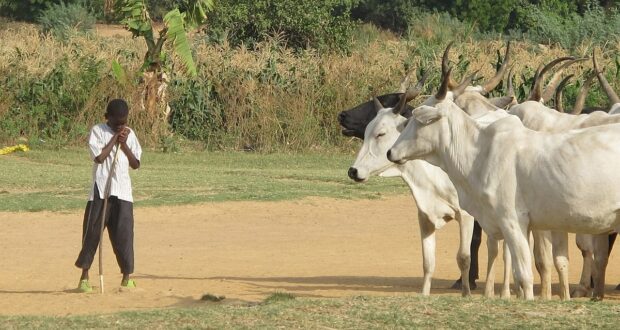3 July, 2023
by Sam Biden, Research Assistant
Development of Christian-Islamic Conflict in Nigeria
Rooted in colonialism, tensions between Muslims and Christians in Nigeria have slowly developed over more than 200 years. Christian missionaries were sent to the country in the late 19th century, particularly the North, to spread Christian beliefs in what was previously the Sokoto Caliphate, a Sunni Muslim caliphate in Nigeria during the time. Islamic beliefs continued despite the imposition of Christianity, causing tears in the social fabric of the previously exclusive Islamic state. When Nigeria gained independence in 1960, new power struggles emerged between the two groups, further exacerbated by the oil boom of the 1970s, resulting in a greater economic disparity between social groups as the competition for natural resources began to rise.
This competition has continued on until today and remains a large contributing factor for many attacks that have happened in the last decade, often between transhumance groups of opposing religions. With religious tensions continuing to grow, the introduction of Sharia Law in some provinces of Northern Nigeria in the 1990-2000s followed by the sudden rise of Boko Haram, an Islamist terrorist group that became most prominent in 2009, caused many Christian communities to fear for their rights and protections under Nigerian legislation as they fell directly under Islamic rule.
A major fragmentation of the two religions into smaller groups has occurred, while new groups without a religious basis emerge as competition.
Conflicting Parties in Contemporary Nigeria
The violence witnessed in northern Nigeria can be classified into three distinct dimensions, each characterized by its unique dynamics and actors involved.
The first category centers around conflicts between ethnic Hausa farmers and smaller groups acting on their behalf against the rival Fulani herders and their militias. The Hausa people are strict Muslims and the largest native group in Central and West Africa, with a predicted population of 20 million, many of them farmers who engage in transhumance. The Fula people are also of Islamic origin, having been the first group in the region to convert to Islam in the 16th century. Members of the Fulani militia who engage in violent acts are amongst the most aggressive and recognizable sub group in the ongoing conflict, being credibly responsible for the majority of attacks against farmers since 2009, even being labeled as one of the five most dangerous terrorist organizations by the Global Terrorism Index in 2015. In recent decades, they have been forcefully pushed out from many areas of Northern Nigeria towards the ‘Middle belt’ in the center of the state, dangerously closer to the predominantly Christian areas of the South. Both groups operate in a decentralized manner, functioning under the autonomous control of local commanders in smaller regions with the primary objective of defending herders in disputes with farmers over the scarcity of natural resources and crossing of borders between Northern areas.
The second category entails violence perpetrated by smaller criminal gangs, often categorized as bandits, involved in large-scale cattle theft, ransom kidnappings, armed robberies, looting and attacks on gold miners and traders. These groups are not strictly associated with the Hausa or Fulani groups engaged in violent acts but are individuals from diverse ethnic backgrounds, being primarily driven by personal enrichment as opposed to political or ideological goals. These criminal organizations also lack centralized command structures and operate independently, often clashing with rival small gangs in smaller regions of Northern Nigeria.
The third and most recent dimension of violence involves clashes between government security forces and jihadist groups that have become increasingly active in the region, such as Ansaru, Ansar Dine and al-Mulathameen. Sometimes described as Nigeria’s own war on terror, the emergence of these jihadist groups stem from the popularity of Boko Haram and the evolution of more extreme Islamic thinking. Government forces have had many direct confrontations with these groups, adding further volatility to an already unstable situation.
On January 24th 2023, a military airstrike in Kwatiri, Nasarawa State, claimed the lives of 39 civilians and left several others injured. The Nigerian air force initially provided little information about the attack, but almost six months later, they admitted to carrying out the airstrike. However, they failed to provide any substantial details regarding the incident or the rationale behind targeting the area, leading to heavy criticism surrounding a lack of internal accountability. Survivors and family members recounted the horrifying aftermath of the airstrike, having described finding bloodied bodies and witnessing severe injuries among those who survived.
Those killed or injured were innocent cattle herders with no evidence linking them to any armed groups, suggesting they are to be considered non-combatants and therefore cannot be the target of any military operations. There are allegations that the attack may have been carried out as a reprisal against the herders for grazing their cattle in Benue State, where the movement of livestock on foot is prohibited by law. The herders had previously been fined a total of 27 million Naira, the equivalent of $58,000 because they transported cattle from the Nasarawa state border into the Benue State, a criminal offense in Nigeria.
Responses to the Attack
Human Rights Watch (HRW) were amongst the first to question the Nigerian government over the attack, initially receiving conflicting and contradictory information. Prior to the exchange of information between HRW and the Nigerian government, HRW visited the site of the attack, interviewed witnesses and reviewed photographic evidence of the attack. The photographs were graphic, showing the mutilated remains of at least 17 cattle herders, none of which had any links to armed groups. Following the visit, the Nigerian government told HRW that they did indeed carry out the attack, contradicting an earlier statement that the attack had been carried out by an ‘unidentified drone’ that was not under the control of the Nigerian government.
The revised testimony of the Nigerian government states that those affected by the attack had been identified as ‘suspected terrorists’ in possession of a logistics truck that was moving from Nasarawa into Benue. The Nigerian government claims that they had received credible intelligence to confirm this testimony, however, they have failed to verify the target identification process used prior to the attack or cite any sources of intelligence that would further support their claim.
UN Special Adviser on the Prevention of Genocide, Alice Wairimu Nderitu, released an immediate announcement in wake of the airstrike. Ms. Nderitu states that it is clear the Nigerian government has a pattern of targeting civilians with airstrikes, citing how counter-terrorism operations in the state are not being conducted within the bounds of international law. This claim is backed up with significant evidence against the Nigerian Air Force with the confirmation of at least 300 civilian deaths since 2017. Most notably, an attack on an internally displaced persons camp in 2017 killed 115 people, followed by the second most deadly attack that caused the deaths of 64 people in Zamfara state in 2022. Ms. Nderitu is concerned about a rise in intercommunal conflict in Northern Nigeria in general, claiming that targeting is being done on ‘identity lines’ that may cause a rise in recruitment to non-state armed groups and retaliatory attacks against the Nigerian armed forces.
Transhumance Targeting
As mentioned prior, the movement of livestock from one grazing area to another, known as transhumance, is not only legally restricted in Nigeria but also a primary cause for conflict between the competing parties.
The International Organization for Migration (IMO), a body of the UN, has highlighted and aimed to reduce tensions regarding transhumance. As a traditional practice in Africa, transhumance is used to increase resilience to the ongoing climate and economic crisis in the region, allowing cross-border food and income for struggling communities in neighboring regions. While transhumance has historically been peaceful, the effects of climate change, environmental pressures and the continued tensions between armed groups have disrupted migratory routes and led to heightened tensions between farming and herder communities, causing shortages of natural resources. To combat this, IMO created the Transhumance Tracking Tool (TTT) as a way to monitor and assist governments in reducing communal tensions over transhumance.
The TTT is very active in Nigeria. IOM has formed partnerships with Mercy Corps and Search for Common Ground, two large organizations aimed at peacebuilding and providing communities with basic necessities, to promote social cohesion and enhance collaboration within communities. With the creation of the Early Warning and Early Response system (EWER), transhumant mobility can be accurately tracked across groups, regions and communities, allowing for pre-planned or reactive responses to potential conflicts between communities. Despite these implementations, groups such as the Fulani militia are still very hostile towards migratory groups.
Group Differentiation
As has been highlighted, there are multiple groups of varying sizes involved in transhumance, attacks on herders as well as terrorist activity. In essence, being able to accurately identify each group that may be involved is becoming increasingly difficult as the influx of violence continues to rise. Innocent herders are being targeted for violating Nigerian legislation, criminal gangs are being targeted for their involvement in a wide array of crimes as well as jihadist groups being at the forefront of anti-terror operations on behalf of the Nigerian armed forces.
With the increase of accurate location information of transhumance in Nigeria, the Nigerian armed forces have a greater understanding of who is a combatant based on this information, although it cannot be perfectly accurate. It must be noted, attacks such as airstrikes that are taken without due caution to the status of the target (such as combatant vs. non-combatant) are a violation of humanitarian law. It’s clear the primary groups involved in organized crime are either Jihadist groups or members of herder collectives such as the Fulani militia, who may be mistaken for innocent herders that are not involved in the conflict. However, this mistake is not permitted by law, the Nigerian government has a direct duty to identify any group they are intending to attack, this duty is heightened further given the similar appearance and activity of innocent herders and criminal organizations.
Conclusion
In conclusion, the Christian-Islamic conflict in Nigeria provided the basis for the ongoing violence, even causing expansion and dissemination of the primary parties into much smaller groups, often fighting against others of the same religion, in the pursuit of enrichment, ideological development and ownership of the already scarce natural resources.
To tackle the ongoing conflict in Nigeria, the government should prioritize two key actions. First, they should foster dialogue and promote understanding between the differing religious communities regarding transhumance. This can be achieved by agreements between the parties such as the formation of humanitarian corridors that innocent herders can use to travel safely, also reducing the risk of government attacks. Second, the government should strengthen security measures to effectively combat criminal gangs and extremist groups, while ensuring that the actions of security forces adhere to international humanitarian and human rights standards. It’s become clear that the Nigerian Air Force have a reluctance to verify the identity of their targets before launching an airstrike, the improvement of due-caution procedures taken before any airstrike is crucial to the mitigation of civilian loss.
Image: A Nigerian boy and his cattle in Kaduna state, Northern Nigeria (Source: Ikani (modified from original) via CC BY-SA 4.0)
 Human Security Centre Human Rights and International Security Research
Human Security Centre Human Rights and International Security Research




